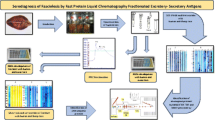Abstract
Burgia malayi andB. pahangi microfilariae were isolated from the blood of infectedMastomys natalensis, and were exsheathed by freezing, thawing and agitation. Pure sheaths were obtained by a filtration procedure. The sheaths were found to contain about 95 mol% of amino acids, with proline, glutamic acid/glutamine, alanine, cysteine/cystine and glycine being the major components, and 5 mol% of carbohydrates, notably (N-acetyl)galactosamine, but no (N-acetyl)glucosamine.
Similar content being viewed by others
References
Bardehle G, Klonisch Th, Schott H-H, Stirm S, Zahner H (1987) Isolation of pure sheaths ofLitomosoides carinii microfilariae. Parasitol Res 74:188–190
Chandrashekar R, Rao RU, Rajasekariah GR, Subrahmanyam D (1984) Separation of viable microfilariae free of blood cells on Percoll gradients. J Helminthol 58:69–70
Devaney E (1985) Lectin-binding characteristics ofBrugia pahangi microfilariae. Trop Med Parasitol 36:25–28
Fontana A, Gross E (1986) Fragmentation of polypeptides by chemical methods. In: Dabre A (ed) Practical protein chemistry. John Wiley & Sons, Chichester, New York, p 78
Fuhrmann JA, Piessens WF (1985) Chitin synthesis and sheath morphogenesis inBrugia malayi microfilariae. Mol Biochem Parasitol 17:93–104
Furman A, Ash LR (1983a) Analysis ofBrugia pahangi microfilarial surface carbohydrates: comparison of the binding of a panel of fluoresceinated lectins to mature in vivo-derived and immature in utero-derived microfilariae. Acta Trop (Basel) 40:45–51
Furman A, Ash LR (1983b) Characterization of the exposed carbohydrates on the sheath surface of in vitro-derivedBrugia pahangi microfilariae by analysis of lectin binding. J Parasitol 69:1043–1047
Geyer R, Zahner H (1987) Occurrence of albumin and immunoglobulins on the sheath of blood microfilariae ofLitomosoides carinii. Trop Med Parasitol 38:66
Geyer R, Geyer H, Kühnardt S, Mink W, Stirm S (1982) Capillary gas chromatography of methylhexitol acetates obtained upon methylation ofN-glycosidically linked glycoprotein oligosaccharides. Anal Biochem 121:263–274
Haque A, Capron A (1986) Filariasis: antigens and host-parasite interactions. In: Pearson TW (ed) Parasite antigens. Marcel Dekker, New York, pp 317–402
Hirs CHW (1967) Performic acid oxidation. Methods Enzymol 11:197–199
Kaushal NA, Simpson AJG, Hussain R, Ottensen EA (1984)Brugia malayi: stage-specific expression of carbohydrates containingN-acetyl-D-glucosamine on the sheathed surface of microfilariae. Exp Parasitol 58:182–187
Maizels RM, Phillips M, Dasgupta A, Partoni F (1984) Human serum albumin on the surface of microfilariae ofWuchereria bancrofti. Parasite Immunol 6:185–190
Matsubara H, Sasaki RM (1969) High recovery of tryptophan from acid hydrolysates of proteins. Biochem Biophys Res Commun 35:175–181
McGreevy PB, Ratiwayanto S, Tuti S, McGreevy MM, Dennis DT (1980)Brugia malayi: relationship between anti-sheath antibodies and amicrofilaremia in natives living in an endemic area of South Kalimantan, Borneo. Am J Trop Med Hyg 29:553–562
Paulson CW, Jacobson RH, Cupp EW (1988) Microfilarial surface carbohydrates as a function of developmental stage and ensheathment status in six species of filariids. J Parasitol 74:743–747
Piessens WF, McGreevy PB, Ratiwayanto S, McGreevy M, Piessens PW, Koiman I, Saroso JS, Dennis DT (1980) Immune responses in human infections withBrugia malayi: correlation of cellular and humoral reactions to microfilarial antigens with clinical status. Am J Trop Med Hyg 29:563–570
Premaratne UN, Parhouse RM, Denham DA (1989) Microfilariae ofBrugia pahangi in the blood of cats have variable levels of feline IgG on their sheaths. J Parasitol 75:320–322
Rao UR, Chandashekar R, Subrahmanyam D (1987a)Litomosoides carinii: characterization of surface carbohydrates of microfilariae and infective larvae. Trop Med Parasitol 38:15–18
Rao UR, Chandrashekar R, Parab PB, Subrahmanyam GR (1987b) Lectin-binding characteristics ofWuchereria bancrofti microfilariae. Acta Trop (Basel) 44:35–42
Schraermeyer U, Peters W, Zahner H (1987) Formation by the uterus of a peripheral layer of the sheath in microfilariae ofLitomosoides carinii andBrugia malayi. Parasitol Res 76:557–564
Tandon A, Zahner H, Sänger I, Müller H-A, Reiner G (1983) Time course of antibody levels inMastomys natalensis after infections withLitomosoides carinii, Dipetalonema viteae, Brugia malayi orBrugia pahangi Z Parasitenkd 69:681–692
Author information
Authors and Affiliations
Rights and permissions
About this article
Cite this article
Klonisch, T., Bardehle, G., Linder, D. et al. The sheaths ofBrugia microfilariae: Isolation and composition. Parasitol Res 77, 448–451 (1991). https://doi.org/10.1007/BF00931643
Accepted:
Issue Date:
DOI: https://doi.org/10.1007/BF00931643




